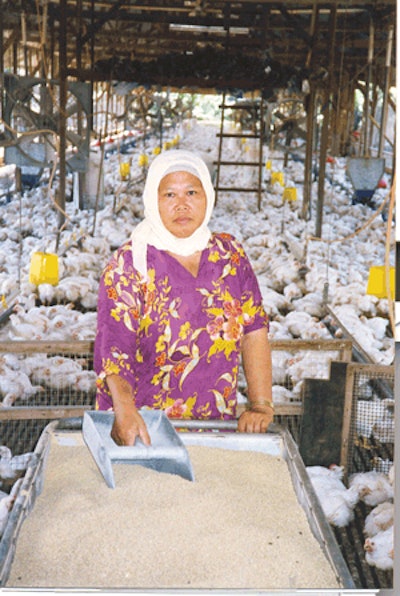
Statements attributed to the Federation of Livestock Farmers' Associations of Malaysia in August this year painted a stark contrast in local poultry production costs between 2006 and 2008. Two years ago, it said, a typical chicken cost RM3.22 per kilogram live weight to produce as the purchase price of a bag of feed was RM54.50. By August 2008, feed was costing RM88 an increase of almost 61.5 percent. The estimated production cost had risen about 56.5 percent to RM5.04 per kilo.
The federation has led a call for higher chicken prices to protect producers' earnings in the face of the feed cost hike. But when the sellers of chickens in Malaysian markets did increase the retail price, some members of the federation's broiler section complained they had seen farmgate prices actually fall, down to just RM4/kg in some cases, as buyers described a drop in demand.
The episode has illustrated the fine balance between supply and demand for broilers in Malaysia. The country has a history of self-sufficiency for chicken meat despite recording one of the world's highest rates of consumption per person/year. It also has a track record as an exporter of poultry and an increase in export potential seems the main target for government plans to support large-scale processing projects in an area known as the East Coast Economic Region (ECER).
Geographical expansion of the poultry industry
Launched last year as a one of a series of development corridors or zones in predominantly rural areas, the ECER measures 66,736 square kilometres, equivalent to 51 percent of the land area of Peninsular Malaysia. Its coverage on the peninsula's east coast comprises the states of Kelantan, Terengganu, Pahang and the northern district of Mersing in Johor. There is also a Northern Corridor that will concentrate on agriculture. But while the eastern corridor is intended mainly to develop its tourism, poultry also appears on the plans.
At present this east-coast zone is reckoned to provide just under 12 percent of the poultry produced nationally. However, the government has set a target for ECER's poultry output to grow by 35 percent between 2005 and 2010. There are reports already of moves to add to an existing plant that processes chickens in Terengganu by building two more in Pahang and Kelatan. Under the 9th Malaysia Plan, Gambang in Kelatan was the nominated site for a new poultry plant processing one million broilers per year. The ECER secretariat has referred meanwhile to the government's promotion of integrated chicken production in the area, taking advantage of local attributes of relatively cheap land and labour. By comparison, a spokesperson commented, land on the west coast of the country has become expensive and in short supply due to rapid industrialisation and development.
Western district dominates
Market reports by the poultry unit of Malaysia's Department of Veterinary Services give more insight into the current geography and structure of broiler production in Peninsular Malaysia. For example, they show that a total of 77 parent-stock farms for broilers were operational in 2007 and 49 of them were in the western district approximately between Kuala Lumpur and the border with Singapore. This contrasted with only five for the whole area of the ECER.
Out of the 26 parent-stock providers last year, the reports identify just two as being based in the eastern states. The northern region containing Perak, Penang, Kedah and Perlis had nine, there were eight more in the central belt combining Malacca with Negeri Sembilan and seven in the southern state of Johor.
Broiler parent stock production across Malaysia has seen a drop in the number of companies, from 28 in 2005 and 2006. The reduction has been almost entirely in operators with a capacity for producing between 5 million and 40 million chicks per year. At the upper end of the scale, however, two companies have been added in the capacity range 40-120 million chicks annually. The national total of 26 companies in 2007 represented an annual day-old chick capacity ranging from 1.53 million to 127.45 million.
Also of note is that eight out of these companies were identified as integrators. Between them, they held a parent-stock inventory of almost 3.3 million birds, against 1.9 million for the non-integrators. Malaysian industry sources have told Poultry International that each of the main poultry feed manufacturers nationwide is integrated with the production of chickens or eggs. The major integrators are the local arm of Thailand's CP Group together with Sin Mah, Federal Flour Mills, Dindings, KFC, Pin wee, Huat lai, Leong hup, Heng feng and KL Supreme. In broad terms, Leong hup accounts for around 30 percent of integrated production whereas Sin Mah holds 20 percent and there are 10 percent shares each for CP and Dindings. KFC produces and processes about 200,000 birds per day for its own outlets. The other players are semi-integrated, producing day-old chicks and selling feed while having no processing activity.
Department of Veterinary Services data indicate that 503.19 million day-old chicks were produced last year in Peninsular Malaysia. Some 471.56 million broilers were marketed. Industry projections for 2008 have been for 548.8 million day-olds and 522.83 million broilers. This was after a forecast that the standing population of parent stock would rise in 2008 to 5.25 million birds, from 5.19 million in 2007.
Integrators contributed over 63 percent of day-old chick production last year, on departmental data.



.jpg?auto=format%2Ccompress&fit=crop&h=167&q=70&w=250)
.png?auto=format%2Ccompress&fit=crop&h=167&q=70&w=250)
.jpg?auto=format%2Ccompress&fit=crop&h=167&q=70&w=250)











